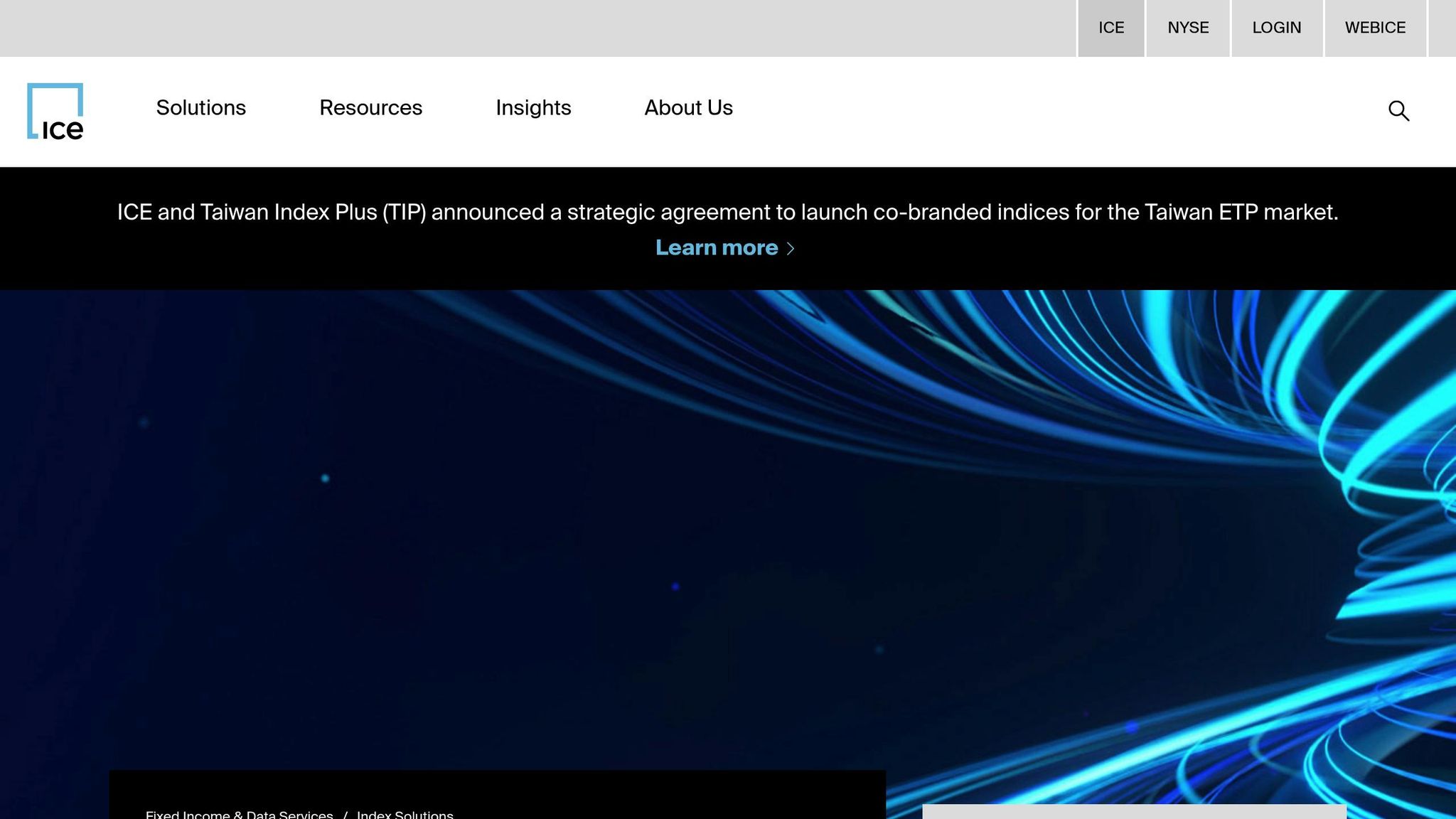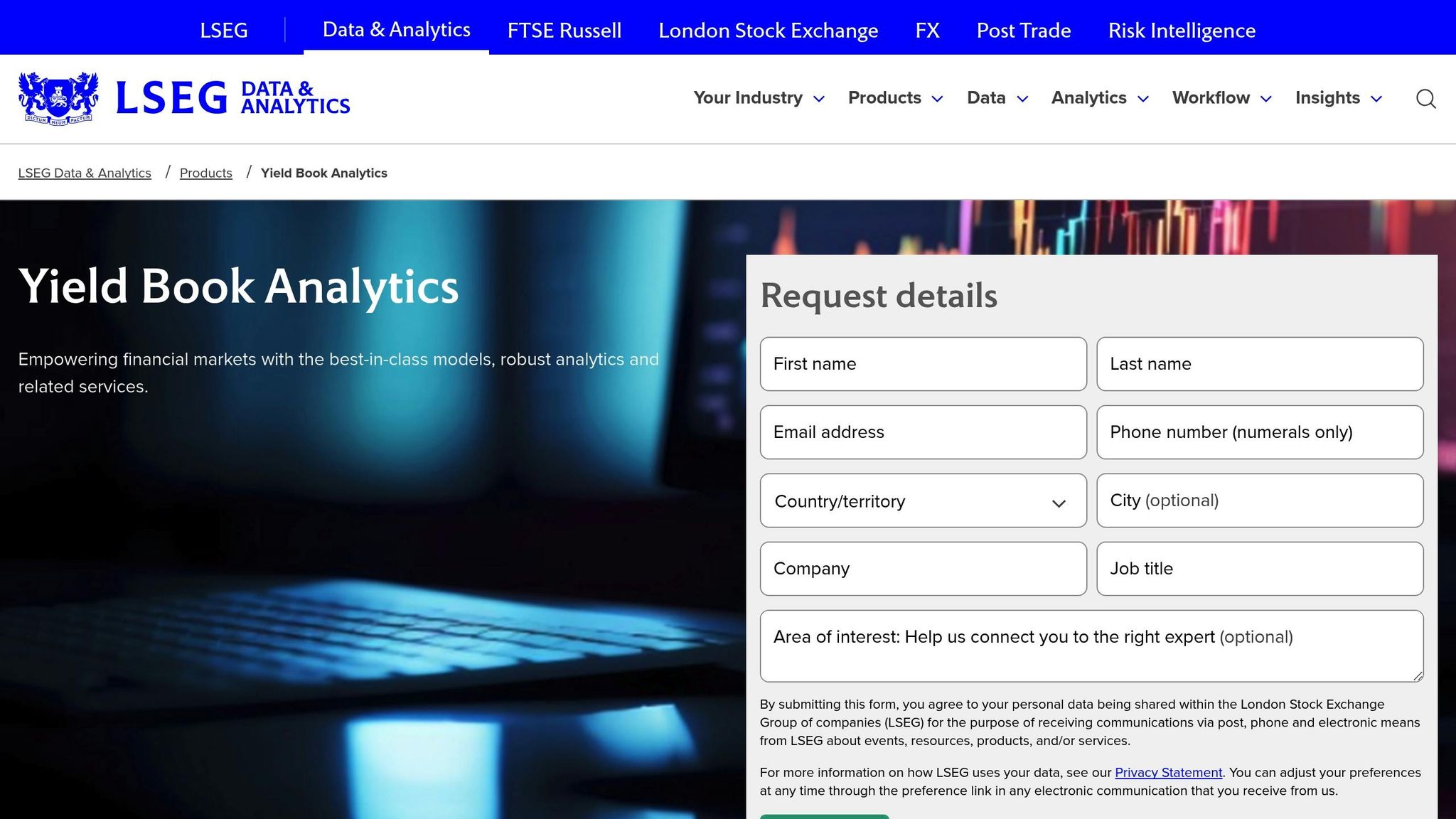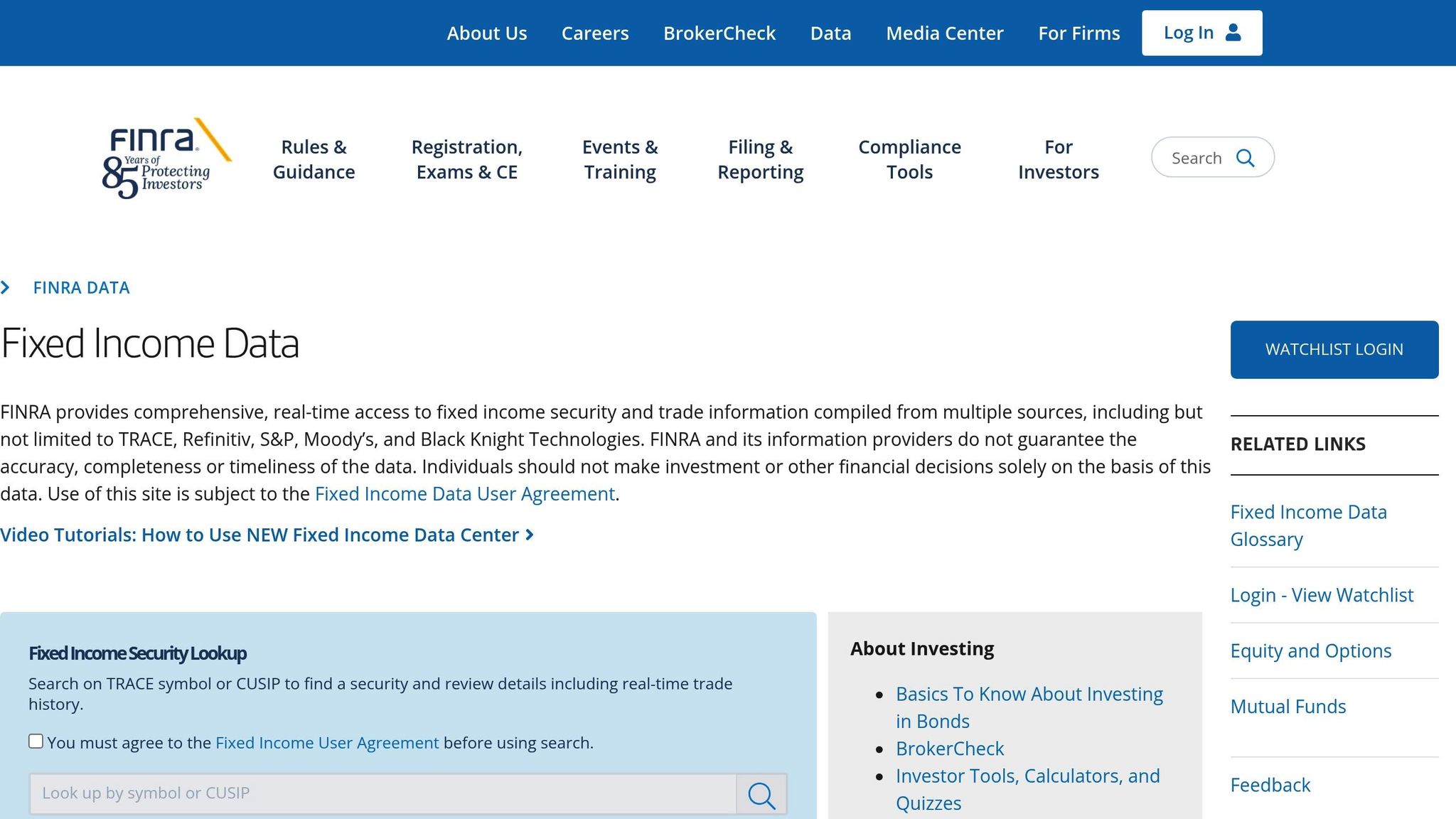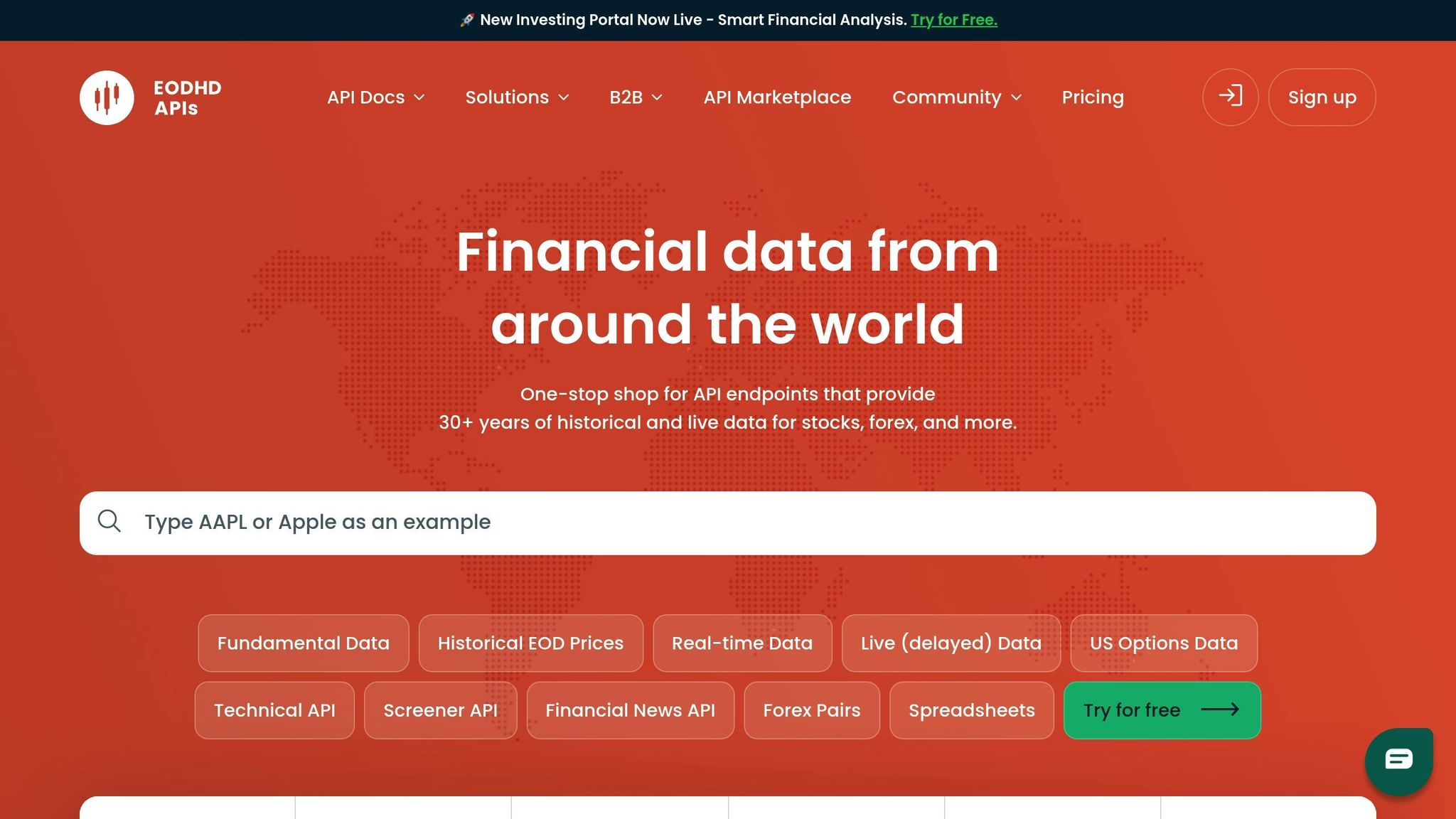Fixed income index platforms are essential for investors looking to analyze historical bond market trends, assess risks, and optimize portfolios. With the U.S. fixed income market valued at $47.4 trillion as of Q1 2025 and trading volumes exceeding $1,503.6 billion in July 2025, access to reliable data is critical for informed decision-making. Here’s a quick overview of the top platforms:
- ICE Index Platform: Tracks over 6,000 indices across 43 currencies, offering extensive global coverage and historical data for institutional investors.
- LSEG Yield Book: Provides 20+ years of daily analytics on over 10 million securities, with flexible delivery options like APIs and Snowflake integration.
- FINRA Fixed Income Data Center: Focuses on U.S. corporate bonds and securitized products via TRACE, ensuring transparency and regulatory compliance.
- EOD Historical Data: API-driven platform offering long-term historical data, ideal for technical users and backtesting.
Each platform offers distinct features, from global data coverage to regulatory-focused insights, catering to diverse investor needs. Below is a detailed comparison of their strengths and delivery methods.
Fitch Ratings at the Heart of Capital Markets–Fixed Income Indices
Key Features to Look for in Fixed Income Index Platforms
Navigating the vast U.S. fixed income market requires tools that offer precise analysis and reliable insights. When evaluating fixed income index platforms, focus on features that ensure easy access to quality data. This is essential for accurate pricing, effective risk assessment, and sound portfolio valuation.
Data Coverage and Historical Depth
Having broad global data coverage and deep historical records is critical for analyzing market trends across different conditions and economic cycles. For instance, LSEG provides weekly data on millions of securities, offering a wide lens for analysis.
The best platforms track bonds throughout their lifecycle, capturing important events like coupon restructures, defaults, and early redemptions. This level of detail is key for studying long-term performance or backtesting investment strategies.
Price discrepancies in the bond market often exceed 10%, highlighting the need for platforms that offer clear data provenance. The ability to trace data back to original sources, such as bond prospectuses and regulatory filings, ensures transparency and accuracy.
Additionally, robust API integration plays a vital role in making this comprehensive data accessible in real time.
Access Methods and API Integration
Efficient data integration is a must for modern investment workflows, making API capabilities a top priority for institutional users. According to recent findings, 86% of firms integrate market data into their portfolio management systems, yet nearly half of smaller asset managers still lack access to real-time trading data.
Platforms with seamless API integration and customizable dashboards allow for timely insights and smooth data flow. This not only streamlines operations but also frees up time for high-value investment decisions. The best platforms also integrate with risk models, trading systems, and regulatory reporting tools, ensuring a unified and efficient workflow.
"The ideal portfolio management system was identified to be a seamless, single, front-to-back system that combines real-time market data with portfolio risk analytics and pre-trade compliance. It also means all data sources should be able to have API integrations to pipe into the single platform." – IMTC
Unified platforms with strong API support simplify portfolio analysis by offering a complete view of the bond market, helping firms stay on top of evolving trends.
Regulatory Compliance and Data Reliability
Regulatory compliance is another cornerstone of reliable fixed income platforms. For example, FINRA's TRACE system captures over 99% of U.S. corporate bond data, ensuring transparency and reliability in the market.
"FINRA plays an important role in regulating and providing transparency to the fixed income securities markets." – FINRA.org
Platforms should also align with specific compliance requirements, such as reporting for Form N-PORT. Leading solutions, like ICE Portfolio Analytics, go a step further by offering tools specifically designed for regulatory needs. Their Rule 18f-4 module helps funds calculate absolute and relative VaR, perform stress testing, and meet other regulatory requirements, all while integrating seamlessly with existing workflows.
Beyond compliance, data reliability depends on adherence to strict quality standards. Accurate, timely, and consistent data forms the foundation for making informed investment decisions in the complex fixed income landscape.
Best Fixed Income Index Platforms for Historical Data
When it comes to accessing fixed income index historical data, a few platforms stand out for their extensive coverage, ease of integration, and compliance with industry standards. Below is an overview of some of the top platforms in this space.
ICE Index Platform

With a legacy spanning five decades, ICE has become a go-to resource for institutional investors seeking fixed income historical data. The platform provides both summary and detailed constituent index data, covering ICE's entire index universe. Users gain access to current and historical performance data, making it a robust tool for analysis.
ICE's indices benchmark an impressive $2.2 trillion in assets under management (AUM) and support over 350 ETFs globally. Ranked as the second-largest provider for passive fixed income fund AUM and sixth among all index providers worldwide, ICE’s influence is undeniable.
The platform tracks approximately 6,000 standard indices, representing over $100 trillion in debt across global bond markets in 43 currencies. ICE Data Indices, LLC ensures compliance with IOSCO Principles for Financial Benchmarks through independent assurance. Additionally, its IOPV business supports data flow for more than 80% of U.S.-listed ETPs, making it ideal for firms managing large-scale fixed income portfolios.
LSEG Yield Book and Fixed Income Data Solutions

LSEG's Yield Book platform brings over 35 years of expertise in fixed income analytics to the table. It serves as a one-stop shop for fixed income data, pricing, indices, and analytics, leveraging LSEG's Pricing and Reference data to build FTSE Russell indices.
"As a trusted and authoritative source of fixed income analytics for more than 35 years, Yield Book offers an expanded set of capabilities that include market-leading data and cashflows modelling for in-depth security and portfolio analysis ranging from vanilla bonds to highly structured mortgages and complex derivatives for clients to comprehensively address their requirements."
The platform boasts a global fixed income database covering over 10 million securities, including government and corporate bonds, U.S. municipal bonds, mortgage-backed securities, CLOs, and derivatives. It also offers historical analytics for over 3.1 million unique securities, with more than 20 years of daily data.
Flexible delivery options, such as Snowflake Data Sharing, allow users to analyze data using pre-configured dashboards tailored to LSEG content. Clients can either use LSEG’s precalculated analytics or input their own pricing for custom analysis. Access is available through various methods, including Yield Book Classic, Yield Book Add-In, Yield Book API, and LSEG DataScope Select, with delivery via web interfaces, Excel, APIs, and FTP.
FINRA Fixed Income Data Center

FINRA plays a critical role in enhancing transparency in the U.S. fixed income market through its data collection and dissemination efforts. The Fixed Income Data Center aggregates security and trade information, with TRACE (Trade Reporting and Compliance Engine) serving as its main data collection tool.
"FINRA provides comprehensive, real-time access to fixed income security and trade information for many types of bonds."
TRACE requires FINRA member firms to report over-the-counter transactions in eligible fixed income securities under SEC-approved rules. The system captures details such as execution time, price, yield, and transaction size for securities like corporate bonds, agency debt, and securitized products. A 2008 study highlighted TRACE’s impact, showing that its introduction in 2002 led to greater transparency, reduced bid-ask spreads, and lower trading costs for investors.
The Fixed Income Data Center is best suited as a regulatory reference, with access governed by the Fixed Income Data User Agreement.
EOD Historical Data

EOD Historical Data specializes in API-driven, long-term historical data solutions. Designed for technical users, the platform integrates seamlessly with tools like Excel and Python, simplifying the data analysis process.
It provides extensive historical coverage across various fixed income categories, making it a strong choice for backtesting and historical analysis. The platform’s API allows for automated, real-time updates, ensuring users have access to the latest data.
For institutional clients, EOD Historical Data offers cost-effective solutions with pricing models that adjust based on usage needs, making it a flexible option for organizations of all sizes. These features make it a versatile choice for those needing detailed historical data.
sbb-itb-2e26d5a
Platform Comparison Table
When choosing a platform, it's crucial to weigh differences in coverage, delivery options, and compliance standards. Below is a comparison of leading platforms to help guide your decision.
| Platform | Data Coverage | Historical Depth | Delivery Methods | Pricing Transparency | Regulatory Compliance |
|---|---|---|---|---|---|
| ICE Index Platform | Tracks 6,000+ standard indices covering over US$100 trillion in debt across 43 currencies | Extensive historical records | Data API for intraday access, desktop/web platforms, ICE Consolidated Feed | Limited public pricing; enterprise-focused | Adheres to IOSCO Principles with independent assurance |
| LSEG Yield Book | Covers fixed income across 100+ countries, including over 18,000 unique bonds | 20+ years of historical index data | Yield Book Classic, API integration, web-based access (including Snowflake Data Sharing) | Custom pricing tailored to usage | Employs rigorous validation to meet regulatory and accounting standards |
| FINRA Fixed Income Data Center | Focuses on U.S. corporate bonds, agency debt, and securitized products via TRACE | Real-time and historical TRACE data since 2002 | Web-based access (requires registration and user agreement) | Free access to regulatory data | Operates under SEC-approved rules with mandatory reporting |
Key Insights from the Comparison
Data Coverage: ICE offers a global perspective with indices spanning 43 currencies, while LSEG provides broad coverage across 100+ countries, including 18,000+ unique bonds. FINRA, on the other hand, focuses exclusively on U.S. markets, offering specialized insights into corporate bonds and securitized products.
Delivery Methods: ICE stands out with intraday API access and desktop/web platforms, while LSEG integrates Snowflake Data Sharing alongside API and web-based tools. FINRA keeps it simple with web-based access, though registration and agreements are required. A notable perspective from QUODD highlights the importance of seamless integrations:
"Programmatic access to global pricing and reference data with seamless integrations into proprietary and/or third-party applications. Anything you can do or access in the digital experience can also be programmatically connected in QX Automate." – QUODD
Regulatory Compliance: FINRA operates under strict SEC-approved rules, ensuring transparency and accountability. ICE aligns with IOSCO Principles through independent assurance, while LSEG employs rigorous validation to maintain compliance with regulatory and accounting standards.
Historical Data: LSEG offers over 20 years of daily analytics, making it a strong option for those needing long-term insights. ICE complements this with extensive global historical records, while FINRA provides TRACE data going back to 2002.
Pricing Transparency: FINRA stands out by offering free access to its regulatory data. In contrast, ICE and LSEG typically negotiate custom pricing agreements based on data needs and usage volumes.
This comparison underscores the unique strengths of each platform, helping users match their specific needs with the right solution.
Conclusion
When selecting a fixed income index platform, it's important to align your choice with your specific data requirements, integration preferences, and regulatory obligations. By assessing factors like data coverage, integration options, and compliance standards, investors can identify the platform that best supports their goals. Each platform discussed brings distinct strengths to the table, making them valuable tools for in-depth investment analysis and portfolio management.
For instance, ICE stands out with its global coverage, offering over 6,000 indices across 43 currencies. LSEG Yield Book provides detailed analytics spanning 100+ countries and more than 20 years of historical data. FINRA, through TRACE, delivers transparent U.S. market data, while EOD Historical Data caters to technical users with its API-driven solutions. Together, these platforms address the essential requirements for effective fixed income data management, ensuring both integration flexibility and adherence to regulatory standards.
FAQs
What should I look for when selecting a platform for fixed income index historical data?
When choosing a platform for fixed income index historical data, it's important to focus on broad data coverage that spans various indices and asset classes. This ensures you have the depth needed for a thorough analysis of market trends and performance.
Equally important is finding a platform with clear and transparent methodologies. Understanding how indices are built and updated helps you trust the data's reliability and consistency over time.
You should also evaluate the accuracy and update frequency of the data, as well as the availability of analytical tools. These tools can help you assess risks and identify trends, giving you the insights needed to make well-informed investment decisions based on historical data.
How do API integrations improve fixed income index platforms for institutional investors?
API integrations play a key role in improving fixed income index platforms by offering real-time data access and smooth connectivity with tools like trading platforms and portfolio management systems. This connectivity allows institutional investors to automate processes such as trade execution and data analysis, cutting down on time-consuming tasks and minimizing manual errors.
These integrations also deliver immediate access to precise bond pricing and analytics, empowering investors to make quicker and more informed decisions. By simplifying workflows and boosting market efficiency, APIs help reduce transaction costs and enhance investment results.
Why is regulatory compliance essential for fixed income index platforms, and how do they maintain it?
Regulatory compliance plays a crucial role in the operation of fixed income index platforms, ensuring they meet legal requirements, safeguard investors, and maintain the integrity of the market. These platforms achieve compliance by leveraging advanced technologies designed to monitor activities, enforce rules, and stay aligned with evolving regulations.
For instance, automated tools are employed to track trade allocations and identify any deviations from established rules. Additionally, platforms fulfill mandatory reporting obligations using systems such as regulatory reporting engines. By focusing on compliance, these platforms not only minimize legal and operational risks but also enhance transparency and promote fairness within the fixed income market.


